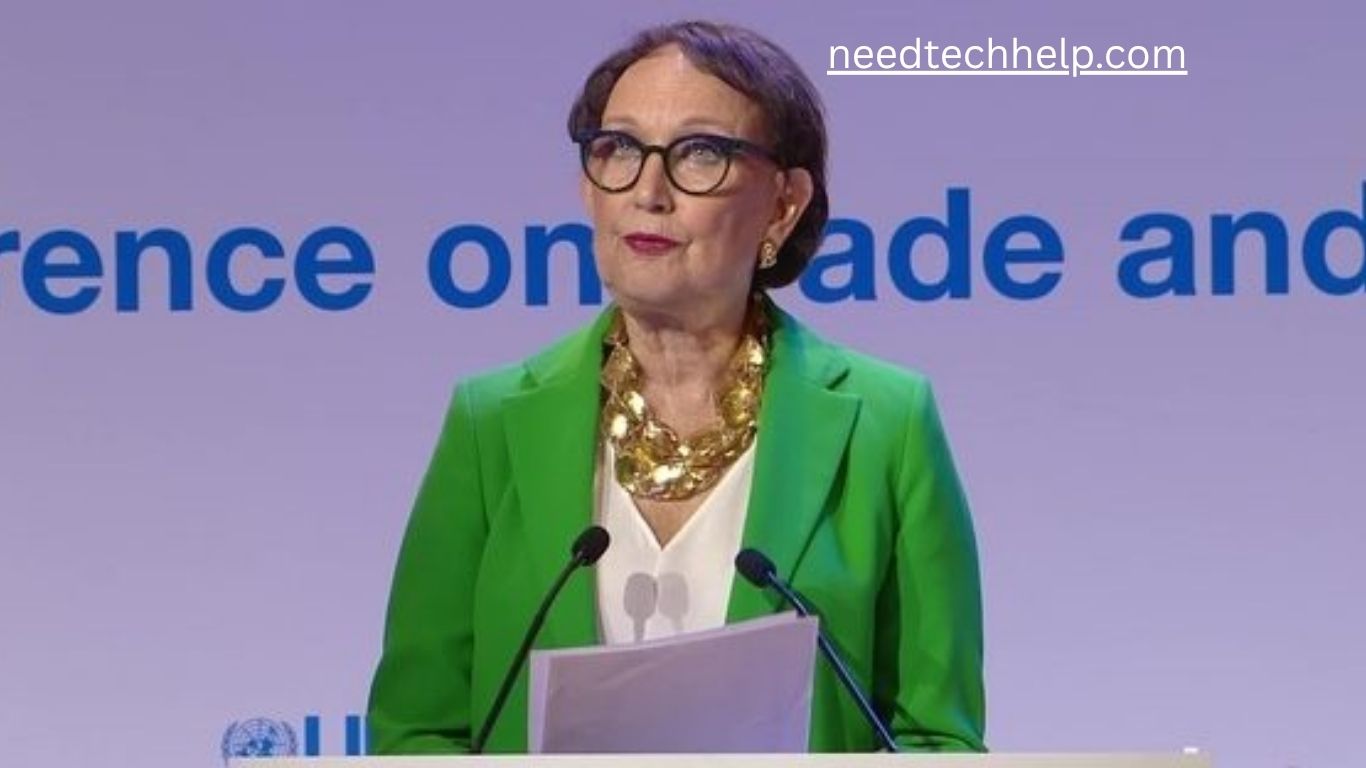At a critical moment for the global economy, Rebeca Grynspan, Secretary-General of the UN Conference on Trade and Development (UNCTAD), delivered a powerful address in Geneva to the organization’s 195 Member States. Her message was clear: the international trading system has survived decades of turmoil only because of continued cooperation, yet new challenges—rising debt, trade wars, and uneven investment—now threaten to reverse hard-won progress.
- The Strength of Rules-Based Trade
- Rising Tariffs and Economic Tensions
- The Debt Trap: A Looming Crisis
- Uneven Investment and the Cost Divide
- Freight Costs and the Geography of Inequality
- AI and the Digital Divide: Opportunities and Risks
- Trust Deficit in the Global System
- Reimagining Trade for Sustainable Development
- Frequently Asked Questions:
- What does the UN mean by a “$31 trillion debt crisis”?
- Why is the global debt situation considered “crushing”?
- How does the debt crisis affect ordinary people in developing nations?
- What role does UNCTAD play in addressing this crisis?
- Which countries are most affected by the $31 trillion debt burden?
- How are rising tariffs linked to the debt crisis?
- What solutions has the UN proposed to manage the crisis?
- Conclusion
Grynspan praised nations for maintaining stability under the World Trade Organization (WTO) framework, noting that 72 percent of global trade still moves under WTO rules. This stability, she emphasized, prevented the kind of economic collapse last seen in the 1930s. But she also warned that mounting tensions, soaring tariffs, and declining trust in multilateral systems are putting development goals in jeopardy.
Read More: http://needtechhelp.com/u-s-envoy-witkoff-expresses-deep-betrayal/
The Strength of Rules-Based Trade
According to Grynspan, the global economy narrowly avoided a “domino effect of tariff escalation” that once crippled world trade. Unlike the Great Depression era, nations today have shown restraint and a commitment to dialogue. “This didn’t happen by accident,” she told delegates. “It happened because you kept negotiating when it seemed pointless, defending a rules-based system even as you worked to reform it, and building bridges even when they fell.”
Her remarks celebrated the perseverance of international cooperation. Despite rising political pressures, countries have continued to rely on multilateral trade agreements to promote predictability and fairness. This cooperation has been vital for millions of people in developing nations who depend on global trade to escape poverty.
Rising Tariffs and Economic Tensions
However, that progress is now under strain. Over the past year, major economies such as the United States have raised tariffs dramatically—from an average of 2.8 percent to over 20 percent. The resulting uncertainty, Grynspan explained, has chilled investment and slowed growth.
“Uncertainty is the highest tariff possible,” she cautioned. “It discourages investors, weakens confidence, and makes trade as a path to development far more difficult.”
Her comments followed months of growing trade disputes and economic anxiety. As nations compete for dominance in technology, energy, and manufacturing, trade has increasingly become a tool of political leverage rather than cooperation. UNCTAD warns that these divisions could deepen inequality between the Global North and South.
The Debt Trap: A Looming Crisis
Grynspan highlighted an alarming trend—the debt crisis engulfing developing economies. Many low-income nations now face an impossible choice: “to default on their debt or on their development.”
Heavily indebted countries are spending record amounts to service loans, leaving little for health, education, or infrastructure. Debt repayments have reached historic highs, forcing governments to postpone vital public projects and social programs.
In a parallel warning, UN General Assembly President Annalena Baerbock revealed that developing countries owed $31 billion in debt repayments last year alone. “Instead of investing in schools and hospitals,” she said, “many nations are spending precious funds just to pay their creditors.”
This vicious cycle—where borrowing costs rise as economies weaken—has trapped many developing nations in what UNCTAD calls a “debt and development dilemma.”
Uneven Investment and the Cost Divide
UNCTAD’s analysis also points to a troubling imbalance in global investment flows. For the second consecutive year, international investment has declined, “eroding tomorrow’s growth,” Grynspan said.
Current investment structures favor wealthy countries, where risks are lower and profits more predictable. In contrast, investors shy away from poorer nations due to high transaction costs, weaker institutions, and limited infrastructure.
Grynspan illustrated this disparity with a striking comparison: “A single U.S. dollar of investment costs three times more in Zambia than in Zurich.” This inequality not only limits opportunities but also slows innovation and job creation in regions that need it most.
Freight Costs and the Geography of Inequality
Beyond debt and investment, logistics and transport costs have become another barrier to inclusive trade. Freight prices remain “too volatile,” Grynspan noted, particularly hurting landlocked and small island developing states (SIDS).
These nations often pay transport bills up to three times the global average, reducing the competitiveness of their exports and driving up import costs. For vulnerable economies already battling climate shocks and inflation, high shipping costs make trade participation nearly impossible.
UNCTAD has repeatedly called for targeted support for transport infrastructure, green shipping corridors, and digital logistics systems to ease these burdens and help marginalized countries integrate into global markets.
AI and the Digital Divide: Opportunities and Risks
While artificial intelligence (AI) promises to add trillions of dollars to global GDP, Grynspan warned that its benefits are not evenly shared. Fewer than one in three developing countries have national AI strategies in place.
Moreover, 2.6 billion people remain offline, most of them women in developing nations. This digital exclusion widens existing inequalities, preventing communities from accessing modern education, finance, and e-commerce platforms.
Without strategic investment in digital literacy, broadband access, and AI capacity-building, the technological revolution could deepen the divide between advanced and developing economies. Grynspan urged the international community to ensure “technology serves humanity, not the other way around.”
Trust Deficit in the Global System
Baerbock echoed Grynspan’s concerns about the erosion of trust in the international order. Although the global economy now exceeds $100 trillion, half the world’s population has seen little or no income growth in a generation.
This widening gap between wealth and opportunity has undermined confidence in global institutions. Citizens increasingly question whether globalization works for them or merely enriches a few powerful actors.
“Trust in the system is fading,” Baerbock warned. “When prosperity does not reach ordinary people, when fairness is absent, the foundation of cooperation begins to crumble.”
Rebuilding this trust, both leaders stressed, requires transparency, fair trade rules, and equitable access to finance and technology.
Reimagining Trade for Sustainable Development
Despite the grim statistics, Grynspan remains optimistic that collective action can restore balance. She urged governments, businesses, and financial institutions to renew their commitment to inclusive, sustainable trade.
That means reforming debt mechanisms to reduce burdens on the poorest nations, promoting climate-resilient investment, and ensuring that the digital revolution becomes an engine for equality rather than exclusion.
Trade, she emphasized, should once again serve as a pathway out of poverty—not a source of vulnerability. By investing in people, prioritizing sustainable infrastructure, and expanding access to emerging technologies, nations can reignite global growth while protecting social progress.
Frequently Asked Questions:
What does the UN mean by a “$31 trillion debt crisis”?
The United Nations refers to the growing total debt owed by developing countries, which has reached $31 trillion. This figure includes loans from international institutions, private creditors, and bilateral lenders. The crisis highlights how these nations are spending enormous portions of their national income just to repay debt, leaving little room for development, healthcare, or education.
Why is the global debt situation considered “crushing”?
It is termed “crushing” because many developing nations are trapped in a cycle of borrowing to repay existing loans. As global interest rates rise, repayment costs have skyrocketed, forcing countries to cut essential public spending. This economic pressure stifles growth, worsens poverty, and delays recovery from crises like the pandemic and climate disasters.
How does the debt crisis affect ordinary people in developing nations?
The burden of national debt trickles down to citizens through reduced public investment. Governments facing massive repayments often slash budgets for healthcare, education, and social welfare. Infrastructure projects are delayed, and employment opportunities shrink, leading to lower living standards and limited access to basic services.
What role does UNCTAD play in addressing this crisis?
The UN Conference on Trade and Development (UNCTAD) advocates for global economic reforms that make trade and finance fairer. UNCTAD urges debt restructuring, interest relief, and increased investment in developing countries to help restore economic stability and sustainable growth. Its mission is to ensure that trade remains a path toward development rather than a source of inequality.
Which countries are most affected by the $31 trillion debt burden?
The crisis disproportionately affects low- and middle-income nations across Africa, Asia, and Latin America. Countries like Zambia, Sri Lanka, Ghana, and Pakistan have faced severe financial distress, with some even defaulting on debt repayments. Many of these nations spend more on debt servicing than on essential sectors like education and healthcare.
How are rising tariffs linked to the debt crisis?
Rising tariffs—especially among major economies—create uncertainty and lower trade volumes, reducing export earnings for developing countries. With declining revenues and higher import costs, these nations struggle to repay external loans. The UN warns that trade tensions and protectionism worsen debt vulnerabilities and hinder global development.
What solutions has the UN proposed to manage the crisis?
The UN calls for a comprehensive debt relief framework, fairer lending terms, and a stronger global financial safety net. It also advocates for increased investment in green infrastructure, digital innovation, and inclusive growth policies that help developing nations strengthen their economies without relying excessively on debt.
Conclusion
The $31 trillion debt crisis is more than an economic challenge—it is a moral test for the global community. As developing nations struggle under crushing financial pressure, their potential for progress, innovation, and human development is being suffocated. The warnings from the United Nations and UNCTAD serve as a reminder that global prosperity cannot thrive when half the world is drowning in debt.












